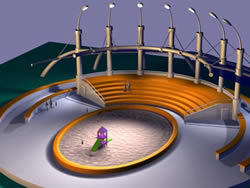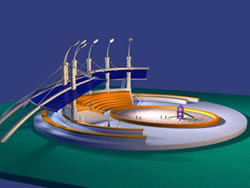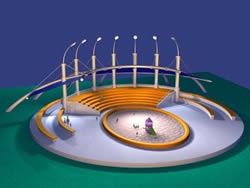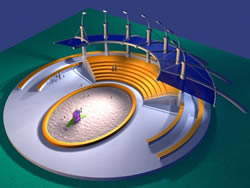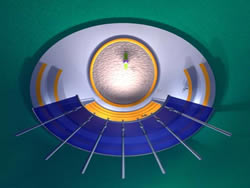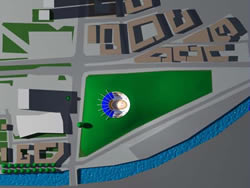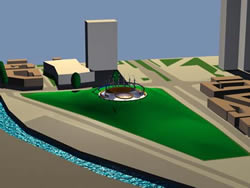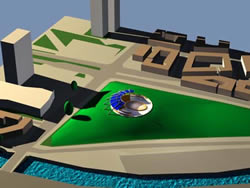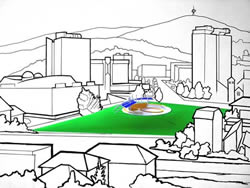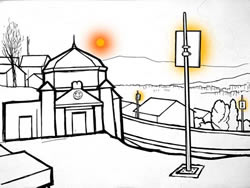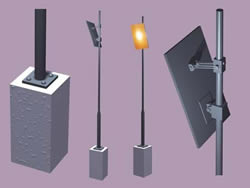Damir Nikšić
MarijinDvorMemorial Park: Wedding/Coronation of Sarajevo
At a lecture given by Ilya Kabakov I heard him saying that every place, every city, had its own spirit, and one needed to spend enough time listening to it, waiting for that spirit to show itself. I remember that I used to sit on Sunday afternoons on the balcony of my parents’ flat. The view from that balcony covered the street that is now called Emerik Blum Street, once known as Belgrade Street, the building that is now housing the OHR and that used to belong to the Unioninvest, stretching all the way to the other part of the city, the hillside know as Seven Forests (Sedam šuma). This time, sitting on the balcony, suddenly I felt that distant and silent reflection of sunset in the window of someone’s house on the hillside at the other side of the city. Someone, there, moved the window-pane, perhaps while having a spring-time tidying up of the house, or a car passed down the steep allies of the mahalas (neighborhoods) and then sunshine would be reflected in the window setting down on the other side of the city, behind Mt. Igman, far behind me. I was fascinated by this link between two intimate worlds, those havens, located on the opposite sides of the city swarming with life. It was only these minimal moves, a reflection in my eye, movement of a car that gave to this stage its life that would then, in a second, disclose itself as a dimension of the city’s genius loci. It is as if one observes an insect that is so merged with the place it sits on and then, in a moment, in a second of its trembling move – we can discern the real contours of that creature. I have been trying for quite a time to capture the spirit, the essence of Sarajevo, in order to transform it into something visible, explicable, to offer it homage, a monument – a monument to the spirit of a city.
An oriental city, conceived as a commercial and spiritual centre, together with its richness, commodities and other valuables, is protected with a belt of mahalas. This city is polycentric since every mahala is a world for itself and a being by itself. Sarajevo is a specific case. The natural amphitheatre has made it so that mahalas and the main commercial centre (čaršija) are at every moment visually merged into one single being. A merchant can see his own home from the doorstep of his shop, while, at dusk, he can see his own shop from the veranda of his home although his public and private lives are completely separated. I believe that this optical linkage of different parts of the city is one of the basic elements that create the spirit of Sarajevo. This natural amphitheatre makes the city the stage for history, while the hillsides are the audience, the witnesses of history. This amphitheatre of life is the place that I would use for my monument. The hillsides surrounding Sarajevo, the slopes of those hills are the witnesses of its history as well as its venue. In the recent war they became the symbol of both occupation and defense of the city. These hillsides have been somehow alienated in the collective memory of the citizens by the war itself and are not seen with the same eye any more. In the war, they were the site of sorrow and tragedy. I would like to revive them again and to present them as my gift to Sarajevo. This amphitheatre would look to the east and would play the role of the seats for the citizens to act as audience, so that they can witness every day the spectacle of sunset and its reflection in the mirrors installed on the sides of its hills. This park and this amphitheatre would thus become the centre for observing this daily rite. The reflection of mirrors is particularly symbolic for me, since they connect the old part of the city with the new one, its periphery with its centre. Human memory is nothing but a flash that connects the visions of people, places, moments, time, meanings and momentary consciousness. To connect a space into a spirit, a meaning, of its time, to connect the old part of the city with the new one, the past of the city and its citizens with their present time, the cemeteries where Sarajevans were buried with the living citizens of the city, whose individual stories and lives are connected with the story and life of the whole city, their histories with the history of the city – and all of it at one place and in one moment – for me that would be the ultimate monument – the monument in the original sense of the word. This work would contain the elements of the first monuments – those that were synchronized and connected with their site, with nature, the cycles of time, lunar changes, sunrise and sunset that used to have an active, pragmatic purpose and role, and were used as devices, as some archetypal machines full of meaning. They were never completely passive monuments, graves, and places of worship or something like that. They were put there for the purpose of celebrating the cycles of nature and of universe, cycles of life, of revival and of awakening and passing away of nature. That is why I believe that such a monument would connect the citizens of Sarajevo with the primordial place, with the spirit of the place we are living in, with its face, its facial features, with time, with eternity and evanescence.
Children’s playground is something that the children of Sarajevo were deprived of. Our kindergartens have been turned into embassies and children do not have a space of theirs in this city. Children – who in the same time symbolize the future and connect us with the future of our city. They remind us that we have only borrowed this city in the course of its existence for a short period of time and that we should leave it behind – as a better place than the one we have gotten on loan. Those who are watching us from the hillsides of this city – they are, among others, the old graveyards with the graves of old Sarajevans – are there only to remind us of the fact that they did the same for us.
I would like to materialize this message and to establish the guards of our conscience, this consciousness of us, our ancestors and our descendants. It is of particular importance that the park I am proposing is located in front of the governmental buildings so that the whole situation happens is merged into one – historically and practically: citizens are overseeing their children, they are overseen by their government, the government and all of us are overseen by our ancestors and by the spirit of the city – its hillsides – the place that stands witness to everything.
Thus I would try to incite and establish the awareness of history and respect for life, the life of the place we are living in.
Project received for the competition for new monument/artwork in public space in the category “Ambience projects / Interventions in nature and urban space”.
